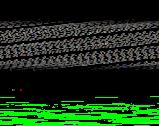


BCD Special Report on
Historic Churches
17th annual edition
23
Before work commenced, the base of the tower was very wet and the timber linings in
the porch were saturated and decaying.
Te tower wall from the south aisle after completion:
damp persists, damaging the new paintwork and
timber linings.
A mason repoints the gneiss walling using a traditional, highly permeable hydraulic
lime mortar to a depth of 150mm.
at an earlier stage. Te structural engineer
required that the tower wall was opened up
so the core could be inspected. He looked
into the possibility of grouting these voids but
considered that the exercise was likely to be an
expensive failure. He recommended repointing
using the appropriate NHL lime mortar for
the situation, also one of Historic Scotland’s
requirements. Te Scottish Lime Centre then
undertook sampling and laboratory research,
including determining the original mortar mix
and composition. It set out recommendations
for the new mortar to be used, which were then
agreed with Historic Scotland. Te original
mortar mix was found to contain locally-
burnt shell lime and beach sand which has
a high proportion of rounded particles, and
was considered unsuitable for pointing the
masonry. Another conclusion was that the
church had probably leaked since it was built,
and photographs taken shortly after it opened
showed much lime staining of the masonry.
Te main reference documents for
repointing work at the time the project was
specifed were Technical Advice Note (TAN) 1
‘Preparation and Use of Lime Mortars’
published in 1995 by Historic Scotland
1
and an
English Heritage study of remedial methods
used to combat dampness in west country
churches, published in 1989.
2
TAN 1 sets out
the technical case and recommendations for
the use of lime-based mortars, particularly in
buildings constructed of dense impervious
stone.
3
Te English Heritage study compared
alternative remedies for impervious stonework
and concluded that repointing with an NHL
(hydraulic lime)-based mortar was the best
solution where walls could not be rendered.
4
Work on site
Using a traditional lime mortar in this remote
island site required good organisation.
Tere was no local contractor with adequate
knowledge of this type of work and
therefore a suitably experienced of-island
stonemasonry frm was employed as the
masonry subcontractor. Although the lime
itself was to be provided ready-prepared, the
mason required the local main contractor’s
men to help him undertake some of the basic
preparatory work. Te enthusiastic main
contractor enrolled himself and his men on a
specialist lime mortar training course on the
mainland to familiarise themselves with this
material, which is rarely used on Barra. Tey
all received commendations for their work.
It was hoped that the project would result in
more local familiarity and acceptance of lime
work, providing greater community beneft.
Lime work would require more frequent
inspection than the architects could provide,
so a very experienced retired surveyor was
interviewed and appointed as a Clerk of Works
by the diocese. It seemed that the stage was set
as well as it could be to suit this island project.
Some internal work began on site in late
2004 but hurricane-force winds in January 2005
caused long delays as the contractor was fully
occupied with emergency repairs elsewhere.
Te scafolding was fnally erected in May 2005.
As work progressed it became clear that the
thicker tower walls would take a very long time
to dry out, even if the repointed walls succeeded
in reducing water ingress. But the wall at the
south aisle arcade grew signifcantly damper: the
gloss painted stone pilaster and arch blistered,
and unsightly stains appeared on the framed
plasterboard and timber lining. Tese areas
are of course very visible to worshippers. Te
porch contains the war memorial, a copper
wall plaque fxed to the timber lining, so had to
be kept as dry as possible. Te priced proposal
had been for an independent framed wall and
ventilated cavity, reducing the porch’s already
small area. On Barra external vents can let in
wind-driven rain, so ventilation had to be to
the interior, which inevitably would become
more humid from the wet walls. After the
decision to reduce the extent of repointing,
with Historic Scotland’s approval a proprietary
drained tanking system was introduced. Tis
kept the original porch foor area and allowed
a new fagstone foor to be laid in place of
slippery and unsightly 1980s tiles; the contractor
completed the work without afecting contract
period or overall cost. Te fact that moisture
cannot now evaporate from the porch walls
is unlikely to have caused the increased
dampness on the nave side, as the rubble wall
core provides a multiplicity of routes for damp
percolating eventually into the sandy sub-foor.
Persistent damp in the
finishedwork
Te specifed remedial work using lime-based
mortar followed established best practice, but
without success: damp still afects the same
walls. What went wrong? With hindsight it
seems that the particular circumstances of
the building have thwarted the best intentions
of all involved. It has of course been a very
frustrating experience for everyone.
Originally it was suspected that failures in
the leadwork at the roof/tower junction and in
the nearby roof drainage were making a decisive
contribution to the damp problems below.
Unfortunately, delays in remedying these defects
delayed a clearer diagnosis. Water seepage is
now present in the middle and lower stages
of the tower but not at the thinner top stage,
where the renewed and realigned parapet gutter
keeps the wallhead dry. Tis means that neither
the roof nor the sandstone ashlar facings and
projecting machicolations (the ornamental row
of small corbelled arches) below the parapet
level are likely to be the source of dampness in
lower walls, and this conclusion is supported
by the fact that sandstone elements elsewhere
do not appear to conduct water into the
interior except at the relatively thin window
reveals. Tere is of course more surface water
running over the sandstone from adjacent
walling than if the building was made entirely of
sandstone, but (as in the cement-mortar pointed
remainder) it does not appear to be a signifcant
factor in the tower walls. Te damp source is
clearly the repointed gneiss tower walling.
Te next question was whether the
new mortar was exactly as specifed, but
after opening up it was found to be correct
and well-carbonated. Tis confrmed
that in this instance the established
method of repair was itself at fault.